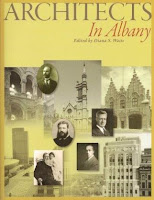 Every once in a while a book shows up that I know will have a permanent place on my desk-side bookshelf. Architects in Albany, a new book by the Historic Albany Foundation and Mount Ida Press, is a collection of profiles and images of the work of 36 designers and their firms that played a major part in forming Albany’s architectural heritage.
Every once in a while a book shows up that I know will have a permanent place on my desk-side bookshelf. Architects in Albany, a new book by the Historic Albany Foundation and Mount Ida Press, is a collection of profiles and images of the work of 36 designers and their firms that played a major part in forming Albany’s architectural heritage.
Edited by Diana S. Waite, the president of Mount Ida Press, this new volume was five years in the making and expands on a booklet the Historic Albany Foundation published in 1978, soon after Albany’s leading historic preservation organization was founded.
Architects in Albany if heavily indexed and includes the work of popularly known local architects like Philip Hooker, Marcus Reynolds, and also the work of builders with a national reputation that worked in Albany like Robert Gibson (Cathedral of All Saints) and Patirck C. Keely (Cathedral of the Immaculate Conception). Albany is unique in that the work of architects brought in by the state is also present in large numbers, and Architects in Albany includes profiles of them as well. Men like Thomas Fuller, H. H. Richardson, and Leopold Eidlitz (State Capitol), are featured along side more recent builders like Edward Durell Stone (SUNY Albany Campus), and Wallace K. Harrison (Empire State Plaza).
The real gems here are the original research, much of it contributed by Cornelia Brooke Gilder, on the lesser known Albany architects. Ernest Hoffman’s late 19th century contributions (15 of them) are documented here. Albert W. Fuller, one of Albany’s more prolific architects, who built Albany Hospital (the original buildings of the Albany Medical Center) and the Harmanus Bleecker Library, but also banks, clubs, apartment houses, a YMCA, several schools, the Dudley Observatory, the Fourth Precinct Police Station, and a number of residences. The book is heavily illustrated.







